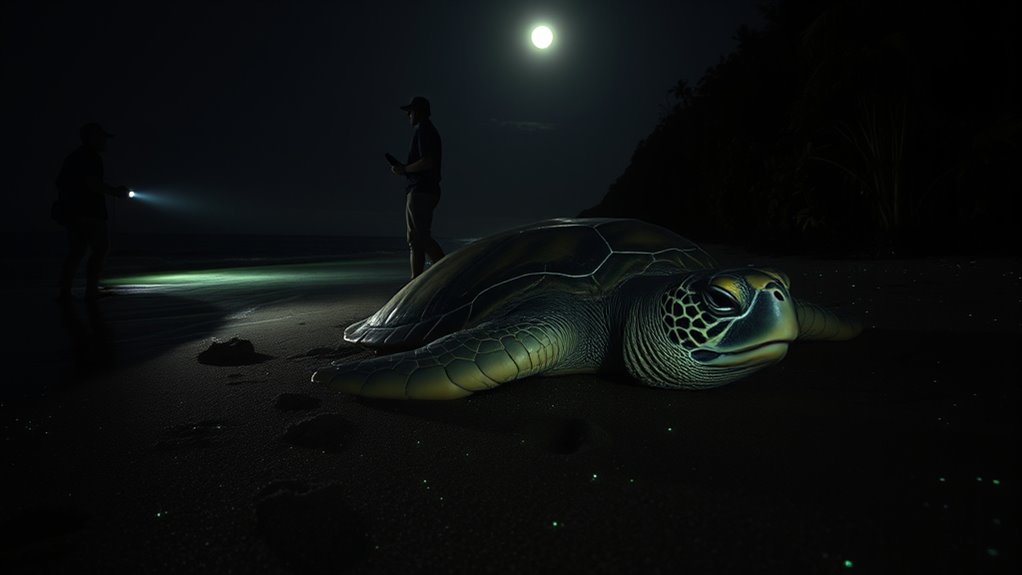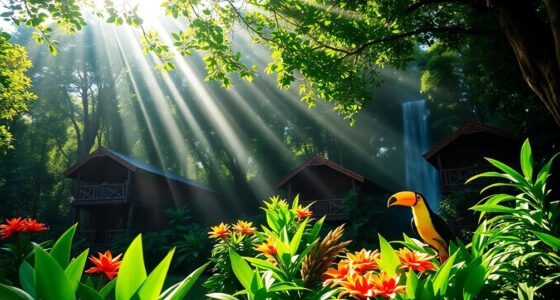Sea Turtle Night Patrols in Tortuguero are essential for protecting nesting sites, hatchlings, and reducing threats like poaching and predators. Volunteers and locals conduct patrols after sunset, using red flashlights to avoid disturbing the turtles. They monitor beaches for tracks, predators, and environmental hazards, helping to guarantee successful nesting and hatchling survival. Challenges include managing lighting and difficult terrain, but recent efforts have led to increased nesting success. Keep exploring to discover more about these crucial conservation work and how you can get involved.
Key Takeaways
- Night patrols in Tortuguero protect sea turtle nests from poaching, predators, and environmental threats during critical incubation periods.
- Conservation teams use red-filtered flashlights and careful techniques to minimize disturbance during beach patrols.
- Community and volunteers play a vital role in monitoring, educating visitors, and reducing threats like pollution and illegal activities.
- Efforts focus on reducing bycatch, controlling predation, and tracking hatchlings to enhance turtle survival rates.
- Climate change impacts nesting patterns and sex ratios, prompting ongoing conservation adaptations in Tortuguero.
The Significance of Sea Turtles in Tortuguero’s Ecosystem

Sea turtles play a essential role in maintaining the health of Tortuguero’s ecosystem. They help control marine pollution by feeding on jellyfish and other invertebrates, which keeps populations in balance. Their nesting activities also contribute nutrients to the beach ecosystem, supporting plant growth. Supporting local biodiversity is crucial for the resilience of these ecosystems, especially when threatened by human impacts. Unfortunately, marine pollution threatens their habitats, making it harder for turtles to find clean nesting sites and food sources. Illegal poaching remains a significant risk, as it targets eggs and adult turtles for their shells and meat. Protecting these creatures isn’t just about saving individual turtles; it’s about preserving the delicate ecological web they help sustain. Your efforts to understand their importance and combat threats are critical for ensuring Tortuguero’s vibrant ecosystem continues thriving.
The Night Patrols: A Key Conservation Strategy
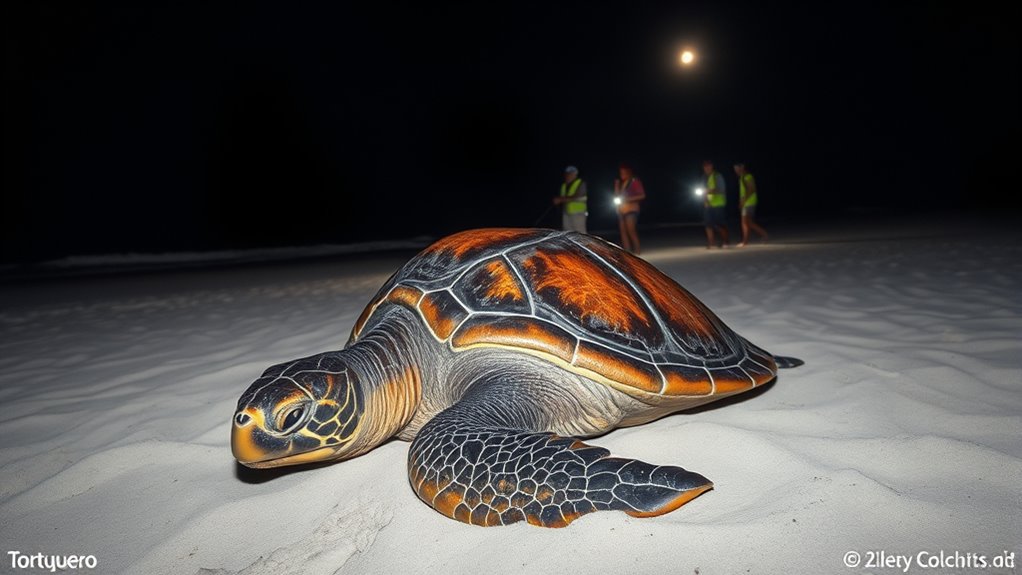
Night patrols are vital for safeguarding sea turtle nesting sites and ensuring hatchlings can reach the ocean safely. By actively monitoring nests, you help protect them from threats like poaching and predators. These efforts are essential for maintaining healthy turtle populations and supporting their long-term survival. Additionally, understanding the importance of color accuracy in visual observation can enhance the effectiveness of patrols during nighttime hours.
Protecting Nesting Sites
How do conservationists guarantee that sea turtle nests are protected from predators and human disturbances? Night patrols play a crucial role by monitoring nesting sites and preventing poaching. They also help minimize threats from marine debris that can obstruct hatchlings or attract predators. Conservationists clear debris from nesting beaches, reducing hazards for emerging hatchlings. Additionally, patrols work to prevent coastal erosion, which threatens nest stability and can wash away eggs. By patrolling at night, they ensure that nests remain undisturbed during the critical incubation period. These efforts help maintain healthy nesting environments, giving hatchlings the best chance for survival. Active nighttime surveillance also involves vetted products to ensure the safety and effectiveness of equipment used during patrols. Overall, active nighttime surveillance safeguards nests from both natural and human-related dangers, strengthening sea turtle conservation in Tortuguero.
Monitoring Hatchlings
Ever wonder how conservationists guarantee hatchlings reach the ocean safely? During monitoring, you help track hatchlings as they emerge from nests, guiding them away from threats like marine pollution and beach erosion. Marine pollution, such as plastic debris, can be deadly if hatchlings ingest or become entangled, so your vigilance minimizes these risks. Beach erosion exposes nests to harsh elements and predators, putting hatchlings at greater danger. By carefully observing hatchlings’ movements, you ensure they find the safest path to the sea. Your efforts also help identify environmental issues affecting nesting beaches, allowing for targeted conservation actions. Monitoring hatchlings is essential to improve survival rates, giving these young turtles a better chance to grow into healthy adults. Utilizing wall organization systems can help keep the monitoring equipment and materials organized, making conservation efforts more efficient.
The Role of Volunteers and Local Communities
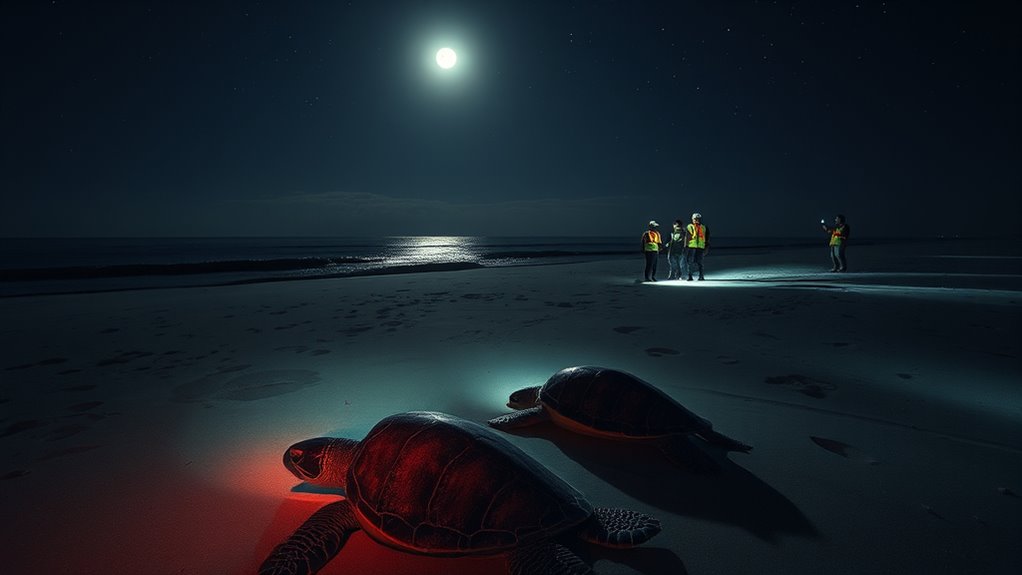
Volunteers and local communities play a crucial role in protecting sea turtles during their nesting and hatching seasons. Your efforts help reduce threats like marine pollution, which endangers both nesting sites and hatchlings. By monitoring beaches, you assist in safeguarding nesting habitats from trash and debris that could harm turtles or disrupt nesting behaviors. Local residents often serve as stewards, educating visitors about the importance of preserving these habitats and minimizing human impact. Your presence also helps deter poachers and illegal activities that threaten turtle populations. Engaging the community fosters a sense of shared responsibility, ensuring that nesting beaches remain protected year-round. Promoting awareness and education about sound design techniques can further enhance outreach efforts. Together, your dedication supports the survival of sea turtles and maintains the health of marine ecosystems in Tortuguero.
Typical Night Patrol Procedures and Techniques
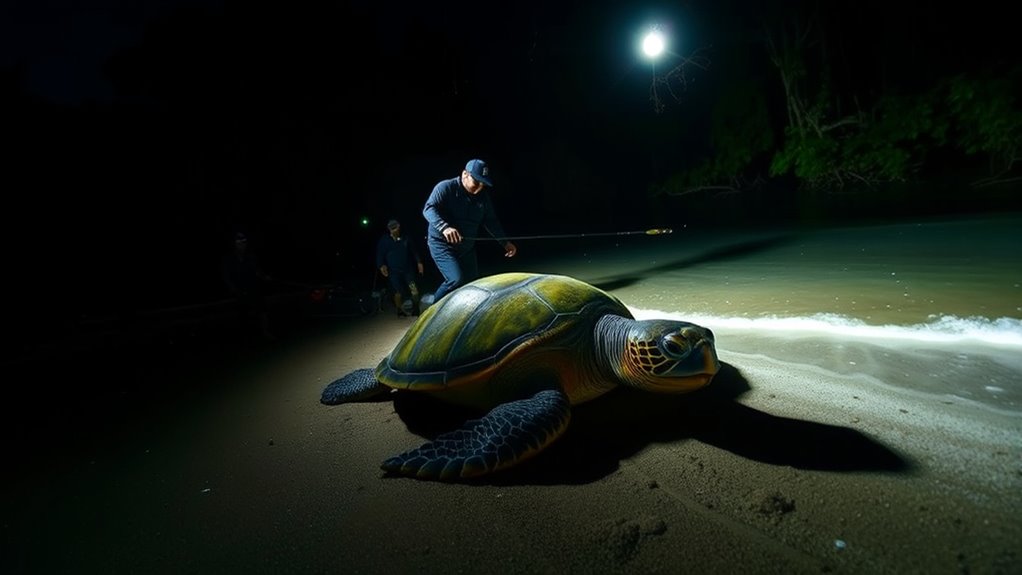
As a night patrol volunteer, you’ll use specific surveillance strategies to monitor sea turtle activity effectively. You’ll need to carefully manage nesting sites to protect eggs and nests from threats. Understanding these procedures helps guarantee that your efforts contribute to the turtles’ safety and conservation. Regular monitoring and documentation of the nests are essential components of effective sea turtle conservation, ensuring timely intervention if issues arise.
Nighttime Surveillance Strategies
Night patrols for sea turtles typically begin shortly after sunset, when the beaches are quiet and turtle activity resumes. You rely on visual cues, such as faint bioluminescent organisms in the water, to monitor the shoreline. To detect approaching nocturnal predators, you stay alert to movement and sounds, adjusting your position as needed. Using flashlights with red filters minimizes disturbance and preserves turtle night vision. You also scan the beach for emerging tracks, ensuring no turtle is missed. Here’s a quick guide to surveillance strategies:
| Technique | Purpose | Key Consideration |
|---|---|---|
| Visual scanning with red filters | Detect turtle activity & predators | Minimize disturbance |
| Monitoring bioluminescent organisms | Identify water movement & predator presence | Enhances detection at night |
| Sound cues & movement detection | Track predator behavior | Stay alert for subtle signs |
| Tracking turtle tracks | Confirm nesting and movement | Record and report findings |
Additionally, understanding the behavioral patterns of sea turtles can improve the effectiveness of night patrols.
Handling Nesting Sites
Once you’ve identified signs of nesting activity through your nighttime surveillance, it’s important to approach the site carefully to avoid disturbing the turtles. Use proper lantern etiquette by keeping your flashlight on a dim red setting to minimize light pollution and prevent nesting disturbances. Stay a respectful distance away, and avoid sudden movements or loud noises that could startle the turtle. When observing, move slowly and quietly, ensuring not to block the turtle’s path or interfere with her nesting process. If you need to document the site, do so discreetly. Remember, your goal is to protect the turtle’s natural behavior while gathering necessary information. Respectful handling of nesting sites helps ensure future generations of sea turtles can continue their essential nesting activities undisturbed. Practicing patience and vigilance is crucial for successful conservation efforts in the field.
Challenges Faced During Night Patrols
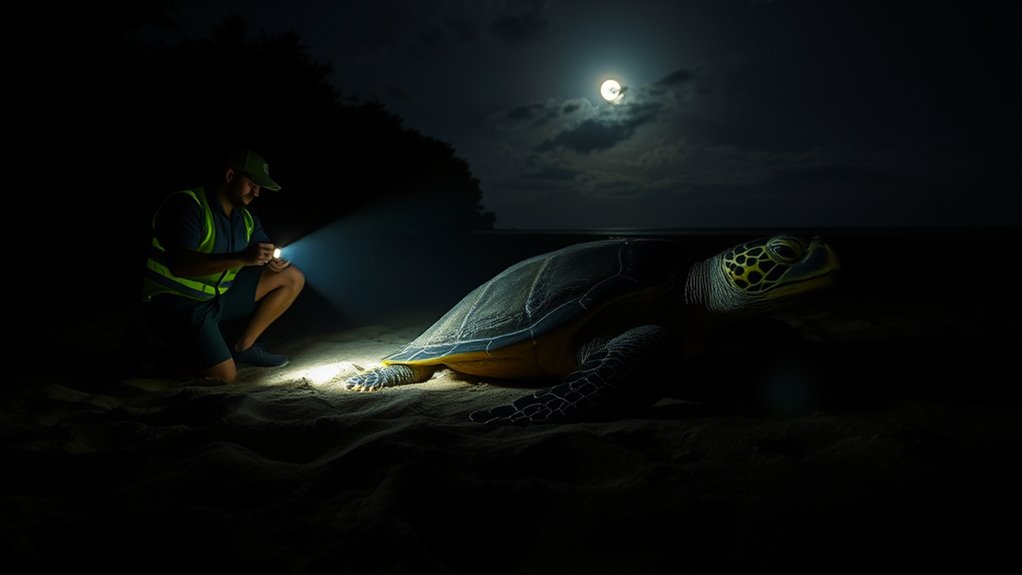
Conducting night patrols to protect sea turtles presents numerous challenges that can hinder conservation efforts. One major issue is lighting challenges, as artificial lights from nearby developments can disorient turtles and attract predators. Additionally, predator threats pose a constant danger, especially from animals like raccoons and crabs that prey on eggs and hatchlings. Here are some key challenges you face:
- Managing artificial lighting to prevent disorientation.
- Spotting and deterring predators threatening nests.
- Navigating difficult terrain and low visibility.
- Ensuring team safety amidst environmental hazards.
- Maintaining proper nighttime protocols to mitigate these risks effectively.
These obstacles require vigilance, quick decision-making, and effective strategies to succeed in conservation efforts. Overcoming such challenges is crucial to give hatchlings the best chance of survival and protect the fragile nesting environment.
Success Stories and Conservation Achievements

Have you ever wondered how dedicated conservation efforts have turned the tide for endangered sea turtles? Thanks to night patrols, we’ve seen remarkable success stories. One achievement is the significant reduction in bycatch, as patrols help monitor and enforce fishing regulations, protecting turtles from accidental capture. Additionally, community awareness campaigns have led to cleaner beaches, reducing marine debris that can entangle or be mistaken for food. These combined efforts have resulted in increased nesting success and higher hatchling survival rates. The collaborative work of local volunteers, scientists, and conservation groups has made a real difference. Every turtle saved and every hatchling that reaches the sea is a testament to what focused, persistent conservation can accomplish in safeguarding these majestic creatures. Regular monitoring of nesting sites ensures ongoing protection and data collection to adapt strategies effectively.
How Visitors Can Support Night Patrol Efforts
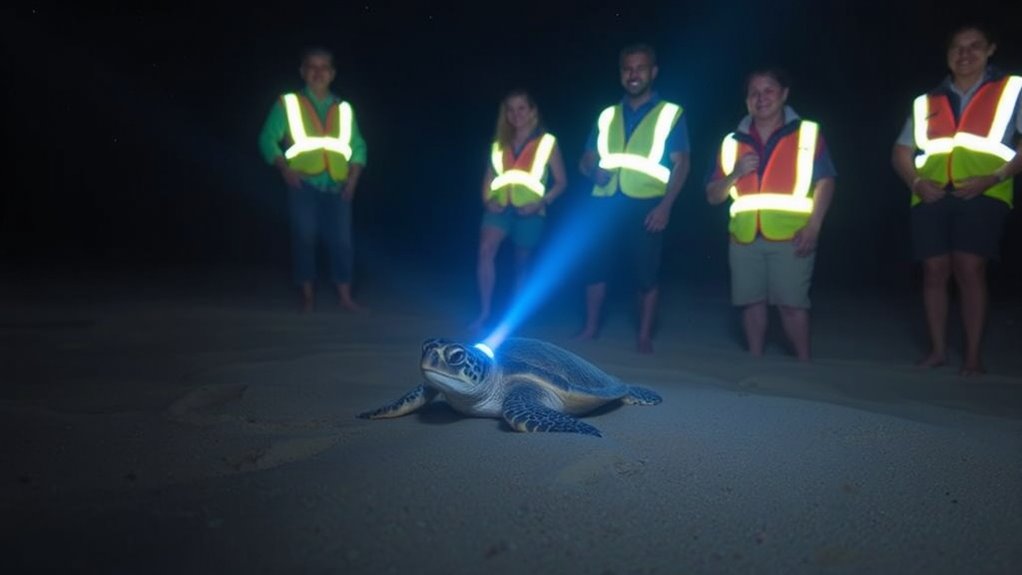
You can play a vital role in supporting night patrol efforts by staying informed and respecting conservation guidelines. Your actions help protect sea turtles from threats like marine pollution and coastal erosion. Here are four ways you can contribute:
Supporting night patrols by staying informed and respecting conservation helps protect sea turtles from pollution and erosion.
- Avoid littering, especially plastics, to prevent marine pollution that endangers hatchlings.
- Follow designated paths and avoid disturbing nesting sites to minimize coastal erosion impacts.
- Refrain from using bright lights or flash photography that can disorient turtles during nesting or hatching.
- Support local conservation programs financially or through volunteering, amplifying patrol efforts.
The Impact of Climate Change on Sea Turtle Nesting
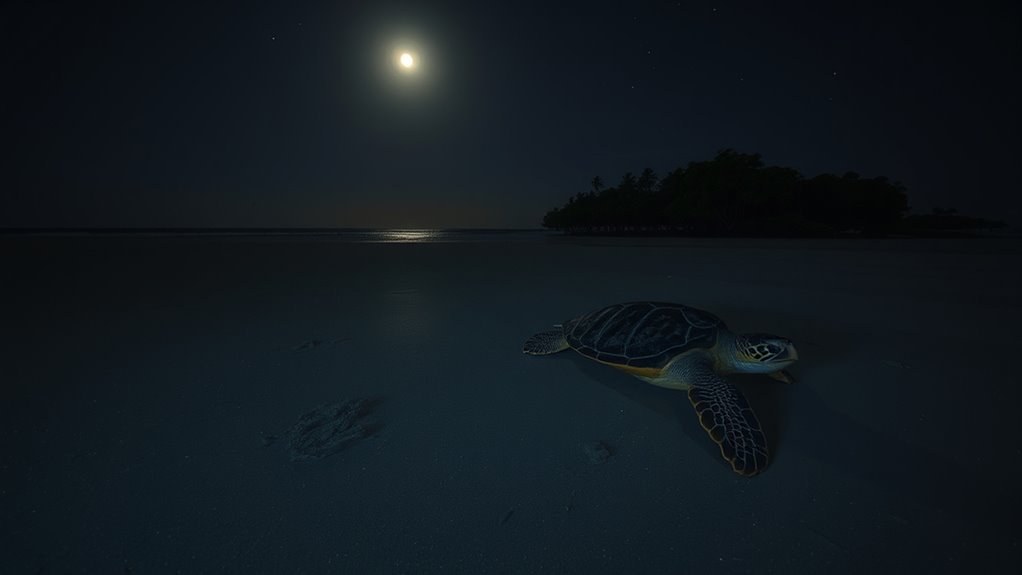
Climate change poses a significant threat to sea turtle nesting by altering the environmental conditions they rely on. Rising temperatures lead to climate induced nesting shifts, causing turtles to lay eggs in less ideal locations or at unpredictable times. Warmer sands influence temperature dependent sex determination, resulting in skewed sex ratios that threaten future populations. When sand temperatures increase, more females hatch, reducing genetic diversity and risking population decline. These changes make nesting sites less stable and harder to predict, complicating conservation efforts. As global temperatures continue to rise, you’ll notice shifts in nesting patterns and challenges in ensuring healthy hatchling production. Addressing these impacts requires understanding how climate change directly affects turtle reproductive biology and nesting success.
Protecting Future Generations of Sea Turtles
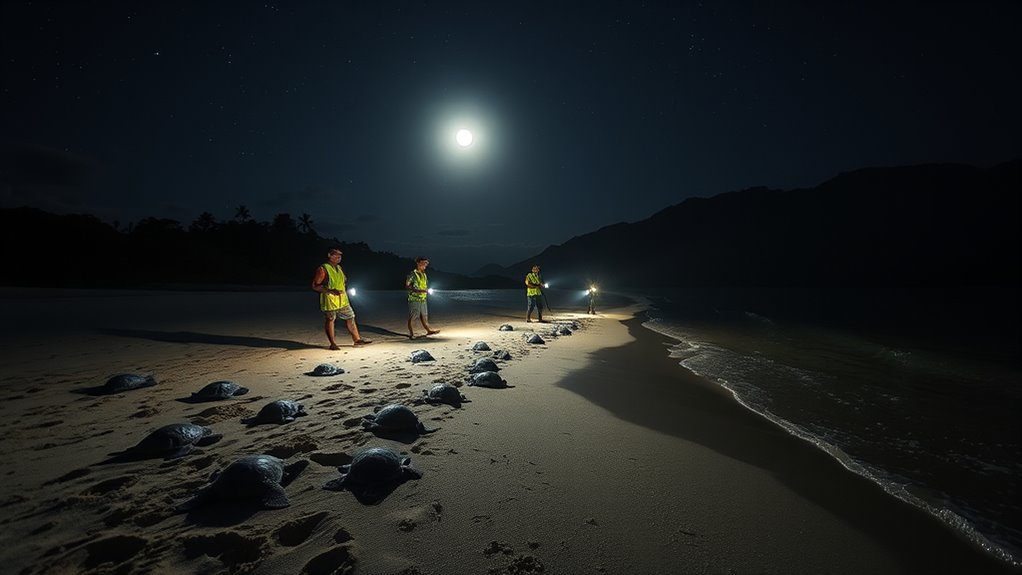
To guarantee future generations of sea turtles thrive, conservation efforts must focus on safeguarding nesting sites and reducing threats that jeopardize their survival. Marine debris and ocean pollution pose significant risks, threatening hatchlings and adults alike. You can help by:
- Participating in beach cleanups to remove debris before nests are laid.
- Advocating for stricter waste management policies to reduce ocean pollution.
- Supporting research to track pollution’s impact on sea turtle populations.
- Promoting awareness about how marine debris causes injuries and entanglement.
Frequently Asked Questions
How Are Volunteers Trained for Night Patrols?
You’re trained through a thorough program that covers turtle behavior, safety procedures, and conservation importance. The training emphasizes volunteer motivations, helping you understand your essential role in protecting sea turtles. Community involvement is key, so you learn how to work alongside locals and support preservation efforts. By participating actively, you contribute to the success of night patrols, ensuring these incredible creatures are safeguarded for future generations.
What Specific Equipment Is Used During Patrols?
Imagine arming yourself with tools that cut through the darkness like guiding stars. During patrols, you use powerful flashlights gear to spot elusive turtles and their tracks. Identification tools help you distinguish species, like decoding nature’s secret messages. Your gear includes sturdy gloves, GPS devices, and sometimes cameras, all essential for protecting these ancient mariners. With each piece, you become a guardian, ensuring their safe journey back to the ocean.
How Do Patrols Identify Different Sea Turtle Species?
You identify different sea turtle species through careful species identification, focusing on unique turtle markings like shell patterns, flipper scars, and head shapes. By observing these distinctive features, you can distinguish between species accurately. Your attention to detail helps guarantee proper data collection and conservation efforts, making sure each turtle is correctly identified and protected based on its specific characteristics.
Are There Any Safety Protocols for Volunteers at Night?
When participating in night patrols, your volunteer safety is a top priority. Always follow night patrol precautions, such as wearing reflective gear and staying alert to your surroundings. Listen carefully to instructions from experienced leaders and avoid risky behaviors. If you encounter any hazards or feel unsafe, communicate immediately. These measures help protect you while ensuring the success of the patrols. Your awareness and adherence to safety protocols make a difference.
How Is Data Collected and Recorded During Patrols?
Imagine you’re a detective in the night, uncovering secrets of the sea. During patrols, you record data meticulously, like stitching together a marine conservation quilt. You use waterproof notebooks or digital devices to log turtle sightings, nesting details, and environmental conditions. Your observations become part of citizen science efforts, helping scientists understand and protect these ancient mariners. Accurate data collection guarantees your nocturnal quest contributes meaningfully to marine conservation.
Conclusion
By joining the fight to protect sea turtles, you become a guardian of their future—like a lighthouse guiding them through darkness. Your support, whether through volunteering or spreading awareness, illuminates the way for these majestic creatures to thrive. Together, we can turn the tide against threats and ensure that generations to come will witness the gentle glow of sea turtles nesting peacefully in Tortuguero’s night. Will you answer the call to protect their tomorrow?

